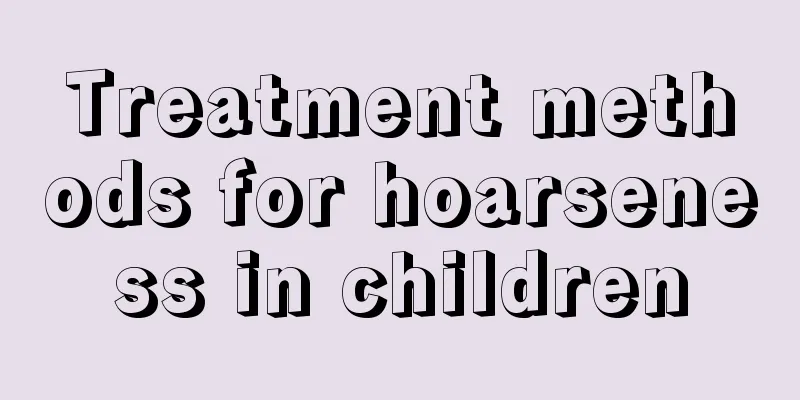Treatment of precocious puberty

|
Everyone hopes that their children can grow up healthily, but there are always some diseases that will affect the baby's health, and precocious puberty is a disease that endangers children's health. The symptoms of precocious puberty are different for boys and girls. Parents are of course more concerned about the treatment of precocious puberty and how to keep their children away from the difficulties of precocious puberty. Of course, for parents and friends, there are many reasons for precocious puberty. Of course, for parents and friends, it is necessary to prevent the occurrence of precocious puberty in daily life. Of course, if precocious puberty occurs, the most important thing is to go to a professional hospital to learn about the treatment of precocious puberty and let the child grow up healthily. 1. Medication The treatment goal of CPP is to improve the child's adult height, and attention should also be paid to preventing psychological problems caused by precocious puberty and early menarche. GnRH analogs (GnRHa) are generally used to treat CPP. The sustained-release GnRHa preparations currently available in China for children include triptorelin and leuprorelin acetate. GnRHa can effectively inhibit the secretion of LH, causing the development of gonads to be suspended and the secretion of sex hormones to return to the pre-pubertal state, thereby delaying the growth and fusion of epiphyses, and achieving the goal of extending the growth years and improving the final adult height as much as possible. (1) Indications for the use of GnRHa 1) To achieve the goal of improving lifelong height in adulthood. The applicable indications are children with significantly impaired growth potential and those with residual growth potential, that is, those with significantly advanced bone age and epiphyseal fusion that has not yet begun. The specific recommendations are as follows: ① Bone age ≥ 2 years old; girls ≤ 11.5 years old, boys ≤ 12.5 years old. ② The predicted adult height for girls is <150 cm, for boys is >1, the bone age/height age is >1, or the height SDS age increase determined by bone age is >1. 2) Indications for caution: The efficacy of improving adult height is poor and it should be used with caution in the following situations: ① When starting treatment, the bone age of girls is >11.5 years old and that of boys is >12.5 years old. ② For those whose genetic target height is 2 standard deviations lower than the normal reference value, other causes of short stature should be considered. 3) Indications for not using GnRHa alone for the following conditions have no significant effect on improving adult height: ① bone age of girls ≥ 12.5 years old and boys ≥ 13.5 years old; ② one year after menarche for girls or spermatorrhea for boys. 4) Indications for non-application ① When the sexual maturation process is slow (bone age progression does not exceed age progression) and the impact on adult height is not significant, no treatment is required. ② Although the bone age is advanced, the height growth rate is fast, which makes the height age greater than the bone age, and it is predicted that the height in adulthood will not be affected. However, since the process of puberty and maturation is dynamic, the judgment of each individual should also be dynamic. Once the diagnosis of CPP is established, those who are initially deemed not to need treatment temporarily need to have their height and bone age checked regularly, the necessity of treatment re-evaluated regularly, and treatment plans formulated as needed. (2) GnRHa application method 1) Dosage: The first dose is 80-100 μg/kg, and it is boosted once after 2 weeks. Then it is administered once every 4 weeks (not exceeding 5 weeks) at a dose of 60-80 μg/kg. The dose needs to be individualized according to the suppression of gonadal axis function (including sexual characteristics, sex hormone levels and bone age progression). Those with poor suppression can refer to the first dose. In order to accurately understand the progression of bone age, clinical physicians should personally assess and compare the bone age before and after treatment, and should not make judgments based solely on the report of the radiology department. 2) Monitoring during treatment: Check the secondary sexual characteristics and measure the height every 2 to 3 months during the treatment. Review the GnRH stimulation test at the end of 3 months after the first dose. If the LH stimulation value is at the pre-pubertal value, it indicates that the dosage is appropriate. Thereafter, for girls, only the basal serum estradiol (E:) concentration or vaginal smear (maturation index) needs to be regularly checked, and for boys, the basal serum testosterone level needs to be checked to determine the inhibition of gonadal axis function. Bone age should be checked once every 6 to 12 months, and girls should also have their uterus and ovaries checked by B-ultrasound. 3) Treatment course: To improve adult height, the course of GnRHa treatment generally takes at least 2 years. Treatment should be stopped when girls are 12.0 to 12.5 years old in bone age. If the course of treatment is extended at this time, it is often difficult to continue to improve adult height. For those who start treatment at a young age, if their age has caught up with bone age and their bone age has reached the normal age for puberty (≥8 years old), and their height is predicted to reach the genetic target height, the medication can be stopped to restart their gonad axis function. They should be followed up regularly. (3) Monitoring after drug withdrawal After treatment, the height, weight, recovery of secondary sexual characteristics and recovery of gonadal axis function should be reviewed every six months. Girls generally experience menarche within 2 years after stopping treatment. (4) Management of growth deceleration during GnRHa treatment The growth rate in the first six months of GnRHa treatment does not change significantly compared with that before treatment. After six months, it generally returns to the growth rate of pre-puberty (about 5cm/year). For some children, the growth rate is <4cm/year after 1 to 2 years of treatment. At this time, continued GnRHa treatment will be difficult to improve their adult height, especially when the bone age is ≥12.0 years (female) or 13.5 years (male). Reducing the GnRHa treatment dose does not improve growth but may increase the risk of accelerating bone age. In recent years, the international community has widely used GnRHa and recombinant human growth hormone (rhGH) in combination to overcome growth deceleration. However, it should be noted that for children with a bone age ≥ 13.5 years (female) or 15 years (male), the growth potential of the bone growth plate has been exhausted, and even with the addition of rhGH, the growth improvement is often not significant. The use of rhGH should strictly follow the indications and is generally only used when the child's predicted adult height cannot reach his or her target height. GH should be used in pharmacological therapeutic doses [0.15-0.20 U/(kg·d)], and side effects should be closely monitored during use (the contraindications for the use of rhGH and the monitoring of side effects during treatment are the same as those for other growth retardation diseases). 2. Treatment of the cause For non-idiopathic CPP, emphasis should be placed on simultaneous etiological treatment (such as surgical treatment of sellar region tumors, and simultaneous administration of cortisol to patients with congenital adrenal hyperplasia and CPP). However, for children with hypothalamic hamartoma and arachnoid cyst who do not show signs of increased intracranial pressure, surgery should be postponed and only ICPP should be treated. In summary, precocious puberty is a sexual development disorder with multiple causes, and identification of the cause is crucial. After confirming GnRH-dependent precocious puberty, central organic lesions should be excluded, especially for boys and those under 6 years of age (both sexes). GnRHa treatment may be considered as the first choice for idiopathic CPP, but the indications for its use must be properly understood, and the growth/maturation balance should be monitored, judged, and mastered during treatment to achieve the goal of improving adult height. During the treatment process, you should also try to avoid contact with substances with estrogenic effects, eat a light diet, exercise more, and avoid obesity. So there are many causes for precocious puberty, so there are also many ways to treat precocious puberty. When parents find any abnormalities in their children, do not hesitate to seek medical attention in time, so as not to delay the treatment, so that they can recover their health as soon as possible and stay away from the troubles of precocious puberty. |
<<: What causes dark circles under children's eyes?
Recommend
How to improve children's memory
All activities in people's lives, from simple...
The harm of eating adult food for babies
After the baby is 6 months old, mothers will comp...
What causes yellow eyes in babies?
To know a person’s state of mind, we often have t...
What to do if your child is very stubborn? Solve the mother's troubles
Children in today's families are usually spoi...
What are the benefits of girls learning Taekwondo?
Many children start practicing Taekwondo at an ea...
What to do if your child refuses to take a bottle
We all know that breast milk is the best for babi...
What to do if a four-year-old baby has a fever of 39 degrees
When a baby has a fever, many parents are sometim...
Why do children keep blinking?
There are many reasons why children keep blinking...
What to do if your child has internal heat and can't defecate
Because the climate is relatively dry in spring a...
What medicine should children take for pharyngitis and cough
Compared with adults, children are in the stage o...
What to do if your child falls off the bed
The old saying goes 'roll over at three month...
What medicine should children take for gastrointestinal cold
Gastrointestinal cold in children is a type of pe...
Why is the baby's hair yellow and thin?
Human beings are in a process of development. We ...
Why do babies fart but not poop?
Many times babies will have many problems with th...
What causes children's poor memory?
A child's health is not only reflected in his...









